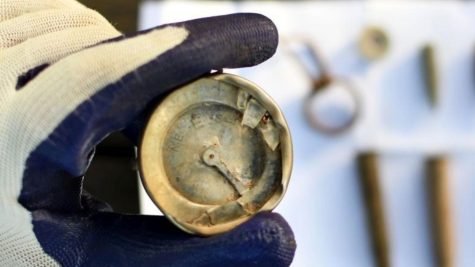Israeli archaeologists recover artifact from ‘The Battle of the 35’
Arabs killed 35 Jews who had run out of ammo during the 1948 Independence War.
Published April 25, 2023
(JNS) It’s easy for archaeologists to detach themselves from ancient finds, but the discovery of a brass compass from a massacre of 35 Israeli soldiers in 1948 left two researchers feeling like they received a “punch in the stomach.” The Israel Antiquities Authority announced on Monday the discovery of the compass from what Israeli history calls “The Battle of the 35” during the War of Independence, known in Hebrew as the story of the Lamed Heh (35 in Hebrew alphabetic numerals).

The story of the compass begins on January 16, 1948, when a convoy of 38 men from the Haganah, the primary paramilitary organization of pre-state Israel, set out to deliver supplies to besieged Jewish communities in Gush Etzion, south of Jerusalem. Three men returned early after one sprained an ankle and couldn’t continue.
The convoy was detected by Arabs who cut off the convoy. After an all-day fight, the Jews ran out of ammunition. The Arabs killed and mutilated all 35 people in the convoy. The massacre and mutilation became known in Israeli history as “The Convoy of 35.”
After the war, the bodies were recovered and reburied at the Mount Herzl Cemetery in Jerusalem.
The compass, as well as Bren-type machine gun pods, were discovered behind a rock at the top of Battle Hill, which apparently served as a shelter for one of the fighters. Forensic research performed at the Israel Police laboratories concluded that the glass of the compass shattered when it was hit by a bullet.
According to the researchers, the compass belonged to either the platoon’s commander, Capt. Danny Mass, or to one of two scouts, Yitzhak Halevi or Yitzhak Zevuloni.
“This study is a kind of punch in the stomach,” said Eyal Marko of the Antiquities Authority, who discovered the compass with Rafael Lewis from Ashkelon Academic College and the University of Haifa.
“It is unlike any archaeological research we have done. Even if the events we studied from the distant past included evidence of destruction and severe acts of violence, the study at Battle Hill is different,” Marko said.
“Although 75 years have already passed since the fall of the 35, here, there are faces and names. There is an almost personal acquaintance with each of the characters. You wonder what happened to the warriors. Or did the compass—which has bullet marks on it—pierce the heart of whoever held it in his pocket or hand? You do the work as scientifically as possible but it is very difficult to detach yourself from the emotional aspect.”
For the past two years, Marko and Lewis have been conducting an archaeological study of Battle Hill. The two men met while serving in an Israel Defense Forces reserve unit tasked with finding missing soldiers. Marko and Lewis employed archaeological methods to search for soldiers whose place of burial is unknown.
In August 1949, a group of former soldiers from the Haganah’s Palmach elite fighting force founded Kibbutz Netiv HaLamed-Heh near the convoy’s route.
| RELATED: Was Topol a spy for Mossad?














